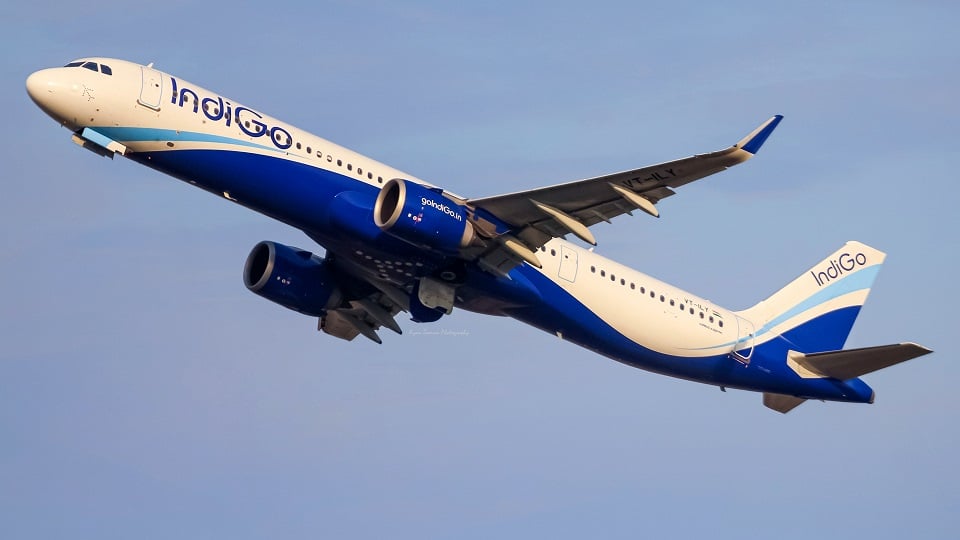Airlines
DGCA imposes $36,000 fine on IndiGo following tail strikes

IndiGo was fined ₹ 3 million ($36,471) by the Directorate General of Civil Aviation (DGCA) on Friday for committing four tail strikes in the course of six months this year. The regulator claimed that after conducting examinations, it discovered several flaws in the airline’s operations, training, and engineering procedures documentation.
In a six-month period in the year 2023, “Indigo Airlines experienced four tail strike incidents on A321 aircraft. The DGCA performed a specialized audit of Indigo Airlines, reviewing their operational, training, engineering, and FDM programme documents and procedures. The paperwork for Indigo Airlines’ operations/training processes and engineering procedures contained several systemic flaws, according to the special audit, it said.
The government’s multiple levels of assessment judged Indigo’s response to the regulator’s show cause notice to be inadequate, according to the ministry. The company said in a statement that it is reviewing the regulator’s order and will respond as soon as possible, adding that the DGCA has given IndiGo one month to file an appeal.
In order to comply with regulatory standards, the DGCA has ordered Interglobe Aviation, which runs IndiGo, to modify its papers and operating procedures.
The DGCA action was in response to two recent incidences in which unauthorized individuals were allowed into the cockpit during scheduled flights. The DGCA had instructed the heads of operations of all scheduled airlines in advice to “prevent any unauthorized entry in the cockpit through appropriate means.” Unauthorized individuals are not permitted in the cockpit under DGCA safety regulations, and any entry that occurs is in violation of regulations.

Airlines
Air India Rolls Out A350s for Delhi-New York JFK and Newark Routes

In a major development for North American travelers, Air India has announced the deployment of its state-of-the-art Airbus A350-900 aircraft on two key routes: Delhi to New York and Delhi to Newark.
The service on the Delhi-New York route will commence on November 1, 2024, while the Delhi-Newark route will see its inaugural flight on January 2, 2025.
The introduction of the air india a350 will bring significant enhancements to Air India’s offerings, particularly with the launch of its Premium Economy class. air india retrofit This new class will feature 24 wide seats arranged in a 2-4-2 configuration, providing passengers with extra legroom and a more comfortable flying experience.
Soon, Air India aircraft will feature onboard WiFi & all-new cabins: Click here
“We are encouraged by the positive guest feedback we have received from the domestic deployment of our air india a350 interior to offer our hero product on the Delhi-New York JFK and Delhi-Newark routes. This is a significant leap forward for our U.S. operations that also underscores our commitment to continuous improvement,” said Campbell Wilson, Chief Executive Officer & Managing Director of Air India.
The A350’s Business class will set new standards with 28 private suites, each equipped with full-flat beds, direct aisle access, and personal wardrobes. Economy class will be configured to accommodate 264 passengers in a 3-4-3 layout. Across all cabins, passengers will enjoy the latest Panasonic eX3 in-flight entertainment system, offering over 2,200 hours of content.
Air India’s First A350-900: Interior, Routes, &Inflight Features: Click here
This strategic deployment marks a notable enhancement in Air India’s U.S. operations, with 60% of its flights to the U.S. now featuring new or upgraded cabin interiors. The air india new international routes currently operates 51 weekly flights to five U.S. destinations: New York JFK, Newark, Washington DC, Chicago, and San Francisco.
The revamped cabins, advanced in-flight entertainment systems, and improved service standards represent air india wifi commitment to providing a superior travel experience. “We believe this enhanced offering will solidify Air India’s position as a leading carrier and attract travellers seeking a world-class flying experience between India and the United States,” the airline stated.
Seats on these flights are now available for booking on Air India’s website, mobile app, and through travel agents, ensuring that passengers can easily plan their journeys on these newly upgraded routes.
Air India Economy vs Qatar airways economy: which is best?:Click here
-

 Travel1 week ago
Travel1 week agoAir India to Expand US Operations with Three New Routes After a Decade
-

 Travel2 weeks ago
Travel2 weeks agoWhy We Should Avoid These Stamps in a Passport
-

 Airlines1 month ago
Airlines1 month agoInvestigations Reveal Fake Chinese Titanium in Boeing and Airbus Jets
-

 Tech4 weeks ago
Tech4 weeks agoChina’s CATL Plans 1,800-Mile Electric Plane Launch by 2027
-

 Airport3 days ago
Airport3 days agoTop 10 Largest Airports in the World by Size
-

 Aerospace4 weeks ago
Aerospace4 weeks agoChina’s Fighter Jets Turn Wings into Autonomous Drones
-

 Airlines4 days ago
Airlines4 days agoAir India Rolls Out A350s for Delhi-New York JFK and Newark Routes
-

 Defence3 weeks ago
Defence3 weeks agoBoeing Enhances Chinook with New Engines and Block II Upgrades at $96 Million







